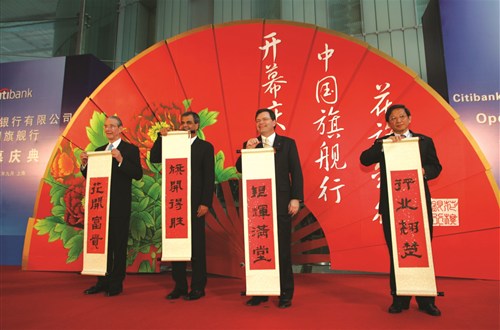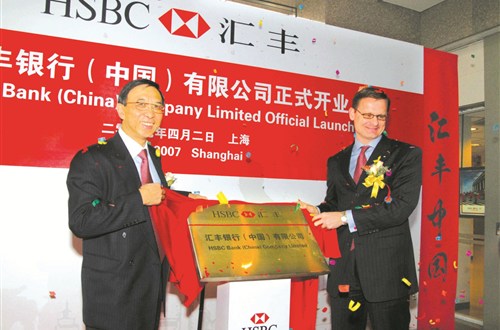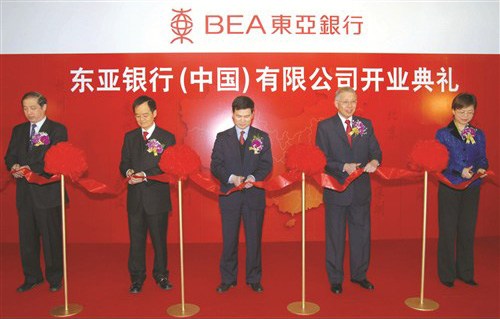Foreign-Funded Financial Institutions Seek Development in Shanghai

Citibank opened its flagship office in Shanghai on September 13, 2005

HSBC China is founded in Shanghai on April 2, 2007

Bank of East Asia (China) Co., Ltd was established in Shanghai on April 2, 2007

Shanghai Pudong Development Bank and Silicon Valley Bank set up the joint-venture SPD Silicon Valley Bank on August 15, 2012
Shanghai has become an important locale for foreign-funded financial institutions. By the end of 2013, the city was home to 428 foreign-funded financial institutions. Of those, banks accounted for 52 percent of all foreign banks in China; joint-venture insurance companies accounted for 46 percent of the national total; joint-venture asset management companies , 53 percent; and foreign-funded insurance companies, 45 percent.
1.Banking
Shanghai hosts more foreign-funded banks than any city in mainland China.
In 1994, Regulations of the People's Republic of China Governing Financial Institutions with Foreign Capital was promulgated by the State Council, and the operations of foreign-funded banks in Shanghai entered a new era.
In 1998, Shanghai branches of eight foreign-funded institutions operating RMB transactions acquired access to interbank lending, securities and bond repurchase markets.
In 1999, the Bank of New York, Mees Pierson Bank and Overseas Union Bank set up branches in Shanghai, and ANZ Bank, the Korean Development Bank, Hanvit Bank and Deutsche Bank began operations in Shanghai’s Pudong New Area.
In 2002, the HSBC Data Processing Center started its operations, the first data processing center established in Shanghai by a foreign-funded bank.
In 2003, eight foreign-funded banks established branches in Shanghai. Hang Seng Bank Shanghai branch was one of them, and it was the first branch established by a Hong Kong bank after the Closer Economic Partnership Arrangement (CEPA) was signed between China’s central government and the government of the Hong Kong Special Administrative Region. Citibank and HSBC became shareholders of Shanghai Pudong Development Bank and Bank of Shanghai, respectively, that year.
In 2004, four branches of foreign-funded banks in Shanghai -- Citibank, HSBC, Bank of East Asia and Mizuho Bank -- won approval to conduct corporate transactions settled in RMB for non-foreign-funded enterprises, the first foreign banks to undertake such operations.
In 2005, Citibank’s flagship branch in China, which is located within the Citibank Tower in Lujiazui, started business in Shanghai, and Citibank also signed a mutual agency agreement on ATM services with China Unionpay. Svenska Handelsbanken founded its Shanghai branch, HSBC Premier’s first branch in mainland China started operations in the city, and Standard Chartered Bank opened its third branch in Shanghai and its Priority Banking Center there.
In 2006, Regulation of the People's Republic of China on the Administration of Foreign-funded Banks was put implemented. According to the regulation, foreign banks registering in China as independent legal entities were allowed to enjoy the same national treatment as Chinese banks in conducting RMB operations for Chinese clients, and there would be no limit in their deposits.
In 2007, Standard Chartered Bank, Bank of East Asia, HSBC, Hang Seng Bank, Mizuho Bank and Mitsubishi Tokyo Financial Group of Japan, the Development Bank of Singapore, Citibank and Algemene Bank Nederland were approved to reconstruct their branches in China to incorporated banks. All of them were registered in Shanghai. In the same year, Swedbank’s representative office in Shanghai was upgraded to branch status, its first branch in Asia. ANZ Bank invested 2 billion yuan in the Shanghai Rural Commercial Bank and acquired a 19.9 percent stake.
Between 2008 and 2013, site location by foreign banks in Shanghai accelerated. RMB transactions and China’s domestic currency transactions conducted by those banks expanded. In 2008, banks from Egypt and Spain opened their first branches in Shanghai. The Shanghai CFETS-ICAP International Money Broking Corporation Limited, a venture between China Foreign Exchange Trade System and ICAP Plc began operations in the city. Shenergy (Group) Financial Company Ltd, jointly owned by the Shenergy Group and Fortis Bank, started its business after acquiring the approval of China Banking Regulatory Commission . The Business Development Bank, China’s first solely foreign-funded bank, was renamed United Commercial Bank (China) Limited, after United Commercial Bank acquired all of its stock.
In 2012, SPD Silicon Valley Bank was established in Shanghai, becoming the first bank in China dedicated to small and medium enterprises, undertaking innovations in science and technology.
2. Securities industry
Shanghai has been one of the ultra-active centers since China launched securities trading. Since the nation’s entry into the WTO, the securities industry has quickened the pace of opening-up to foreign participation.
In 2002, the Administration Measures of Securities Companies and the Administration Measures of Qualified Foreign Institutional Investors to Invest in Domestic Securities were unveiled. In the same year, the preparatory work to set up GTJA Allianz Fund Management Co, a joint venture between Guotai Jun’an Securities Co and Germany’s Allianz Group, officially started. It was the first Sino-foreign joint-stock fund management company to receive regulatory approval in China. It’s registered in Shanghai. At the end of the same year, China Euro Securities, the first Sino-foreign joint-stock securities company set up after the country’s entry into the WTO, was established. It was launched by Xiangcai Securities and France’s CLSA, and was registered in Shanghai.
In 2007, the Pilot Administration Measures of Qualified Domestic Institutional Investors to Invest Overseas was unveiled and implemented. It allowed qualified domestic institutional investors (QDIIs) to invest in overseas securities markets. Hua’an Fund Management Co became the first fund house in China to win a QDII business license and launched the first QDII fund in December that same year.
In 2009, ABC-CA Fund Management Co was founded.
In 2010, BNY Mellon Western Fund Management Co was established.
In 2011, Morgan Stanley Huaxin Securities Co was founded.
In 2012, UBS SDIC Fund Management Co and Mirae Asset Huachen Fund Management Co were set up. Citigroup and Orient Securities joined hands to launch Citi Orient Securities Co.
In 2013, Ashmore-CCSC Fund Management Co was founded.
In 2014, UBS Securities invested in Shanghai Pumin Futures Brokerage Co and took a controlling stake, making the latter the nation’s fourth and Shanghai’s second foreign-controlled futures company.
3. Insurance industry
Shanghai is one of the birthplaces of China's insurance industry. In recent years, foreign insurance companies have experienced rapid development in the city.
In September 1992, American International Assurance Co set up its Shanghai branch. It was the first foreign insurance company approved to enter the Chinese insurance market after the founding of New China.
In 1994, Japan’s Tokio Marine set up its Shanghai branch, mainly providing insurance services to Japanese companies investing in Shanghai.
In 1995, Shanghai set up businesses with insurance and re-insurance companies in more than 200 countries and regions. It commissioned more than 300 inspectors and agents in the world’s major ports.
In 1996, Manulife-Sinochem Life Insurance Co, a joint venture between Canada’s Manulife (International) Ltd and China National Chemicals Import & Export Corp, was set up. It was the first Sino-foreign joint-stock insurance company in China. At the end of the year, Winterthur Swiss Insurance won approval to set up a wholly owned commercial insurance agency in Shanghai.
In 1997, after being approved by the People's Bank of China, American International Assurance Co’s Shanghai branch was divided into AIA Shanghai (life insurance) and AIU Shanghai (property insurance).
In 1998, Dazhong Insurance Co joined hands with Germany’s Allianz Insurance to set up Allianz Dazhong Life Insurance Co. China Pacific Insurance Co and ING Group established Pacific Antai Life Insurance Co. Royal & Sun Alliance Insurance Plc set up a Shanghai branch.
In 1999, France’s AXA Group and China Minmetals Group established a joint venture, AXA-Minmetals Assurance Co.
In 2000, China Life Insurance Co and Commonwealth Bank of Australia set up the joint venture China Life-CMG Life Assurance Co. John Hancock Life Insurance Co in the United States teamed with Tianan Insurance Co to set up John Hancock Tianan Life Insurance Co. Federal Insurance Co of the United States set up its Shanghai branch.
In 2001, South Korea's Samsung Fire & Marine Insurance Co’s Shanghai branch and Mitsui Marine and Fire Insurance Co’s Shanghai branch (after the merger of the parent company, its name changed to Mitsui Sumitomo Insurance Co) were set up. South Korea's Samsung Fire & Marine Insurance Co’s Shanghai branch was the first South Korean insurance company to enter the Chinese market.
In 2002, Qingdao Haier Investment & Development Co teamed up with New York Life Insurance Co to establish Haier New York Life Insurance Co in Shanghai.
This era witnessed the establishment of a series of joint-venture insurance companies, namely Nissay-SVA Life Insurance Co, partnered by SVA (Group) Co and Nippon Life Insurance Co; Citi Life Insurance Co. joint ventured by Shanghai United Investment Co. and Travelers Cos. Inc. subsidiary to National Union Life & Limb Insurance Co; Generali China Life Insurance Co (Shanghai), partnered by Assicurazioni Generali and China National Petroleum Corp; Skandia-BSM Life Insurance Co (Shanghai), joint ventured by Scandia Public Insurance Co and Beijing State-Owned Assets Management Co; CIGNA & CMC Life Insurance Co (Shanghai), joint ventured by Cigna Life Insurance Co and Dingzun Investment Consulting Co; and Cologne Reinsurance Plc (Shanghai), which was later renamed General Reinsurance AG (Shanghai).
From 2006 to 2007, American International Underwriters (Shanghai), Mitsui Sumitomo Insurance (China) Co (Shanghai), Royal & Sun Alliance Insurance Plc (Shanghai) and Federal Insurance Company (Shanghai) were approved to be registered as corporate companies. Lloyd’s Reinsurance (China), a wholly owned subsidiary of Lloyd’s, was also established in Shanghai.
In 2008, Hannover Reinsurance Co (Shanghai) and Cathay Insurance Co started its businesses in Shanghai.
In 2009, HSBC Life Insurance Co started its operations in Shanghai. In the same year, the People’s Government of the Pudong New Area of Shanghai and Zurich Financial Services Group signed the Memorandum of Understanding on Cooperation in Shipping and Finance, under which Zurich Financial Services Group would establish the Zurich International Shipping & Finance R&D Center in Pudong.
In 2010, Lloyd’s Reinsurance (China) acquired the license to run direct insurance businesses in China, and it transformed into a direct insurance company the next year. The year 2010 also witnessed the establishment of XL Insurance (China) Co.
In 2012, Fosun Group and Prudential Financial Inc sponsored the establishment of Pramerica Fusun Life Insurance Co. In 2013, AXA Group acquired the equities of Tianping Auto Insurance Co and then merged Tianping Auto Insurance Co and Winterthur Insurance Co, a foreign-invested property insurance company in China, establishing AXA Tianping P&C Insurance Co.
In February 2014, Starr International Group gained approval from the China Insurance Regulatory Commission to increase its shareholdings and hold the shares of Dazhong Insurance Co.